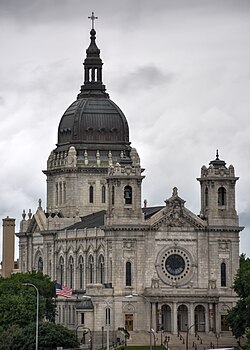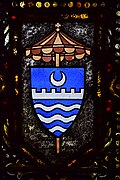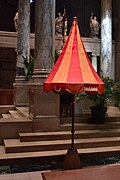
St. Raphael's Cathedral is a Catholic cathedral and a parish church in the Archdiocese of Dubuque located in Dubuque, Iowa. The parish is the oldest congregation of any Christian denomination in the state of Iowa. The cathedral church, rectory, former convent, and former parochial school building are contributing properties in the Cathedral Historic District on the National Register of Historic Places.

The Cathedral Basilica of Our Lady of Peace is the mother church and cathedral of the Diocese of Honolulu.

The Basilica of the National Shrine of the Immaculate Conception is a Catholic minor basilica and national shrine in Washington D.C.. It is the largest Catholic church building in North America and is also the tallest habitable building in Washington, D.C. Its construction of Byzantine and Romanesque Revival architecture began on 23 September 1920.

The Cathedral of Saint Paul is a Roman Catholic cathedral in the city of Saint Paul, Minnesota. It is the co-cathedral of the Archdiocese of Saint Paul and Minneapolis, along with the Basilica of Saint Mary in Minneapolis. One of the most distinctive cathedrals in the United States, it sits on Cathedral Hill overlooking downtown Saint Paul and features a distinctive copper-clad dome. It is dedicated to Paul the Apostle, who is also the namesake of the City of Saint Paul. The current building opened in 1915 as the fourth cathedral of the archdiocese to bear this name. On March 25, 2009, it was designated as the National Shrine of the Apostle Paul by the United States Conference of Catholic Bishops. It is the third-largest Catholic cathedral and sixth-largest church in the United States.

The Cathedral Church and Minor Basilica of the Immaculate Mother of God, Help of Christians, Patroness of Australia is the cathedral church of the Roman Catholic Archdiocese of Sydney and the seat of the Archbishop of Sydney, currently Anthony Fisher OP. It is dedicated to the "Immaculate Mother of God, Help of Christians", Patroness of Australia and holds the title and dignity of a minor basilica, bestowed upon it by Pope Pius XI on 4 August 1932.

The Cathedral Basilica of the Immaculate Conception is a cathedral serving Roman Catholics in the U.S. city of Mobile, Alabama. It is the seat of the Archbishop of the Roman Catholic Archdiocese of Mobile. The cathedral is named for Mary, mother of Jesus, under her title, Our Lady of the Immaculate Conception. It is listed on the National Register of Historic Places as a contributing property to the Church Street East Historic District and Lower Dauphin Street Historic District and is listed on the Historic Roman Catholic Properties in Mobile Multiple Property Submission

The Cathedral Basilica of the Immaculate Conception is the cathedral of the Archdiocese of Denver of the Roman Catholic Church. It is located at the corner of Logan Street and Colfax Avenue in the North Capitol Hill neighborhood of central Denver.

Patrick Charles Keely was an Irish-American architect based in Brooklyn, New York, and Providence, Rhode Island. He was a prolific designer of nearly 600 churches and hundreds of other institutional buildings for the Roman Catholic Church or Roman Catholic patrons in the eastern United States and Canada, particularly in New York City, Boston and Chicago in the later half of the 19th century. He designed every 19th-century Catholic cathedral in New England. Several other church and institutional architects began their careers in his firm.
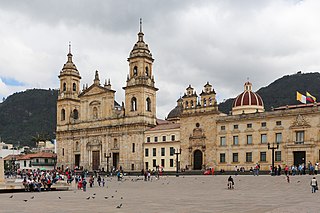
The Metropolitan and Primate Cathedral Basilica of the Immaculate Conception and Saint Peter of Bogotá or better known as the Metropolitan Cathedral Basilica of Bogotá and Primate of Colombia, officially Sacred Holy Temple Metropolitan Cathedral Basilica and Primate of the Immaculate Conception of Mary and Saint Peter, is a cathedral church of Catholic worship consecrated to the Immaculate Conception and under the patronage of Saint Peter; it is a Neoclassical style building located in the Plaza de Bolívar in Bogotá, the country's capital.

St. Mary's Basilica – officially The Church of the Immaculate Conception of the Blessed Virgin Mary – is a church of the Diocese of Phoenix located at 231 North 3rd Street at the corner of East Monroe Street in downtown Phoenix, Arizona. It was previously known as St. Mary's Church. It was built from 1902 to 1914 in a combination of the Mission Revival and Spanish Colonial Revival styles, and was dedicated in 1915. It replaced an earlier adobe church built in 1881 when the parish was founded. From 1895 the parish was staffed by the Franciscan Friars, but it is currently staffed and operated by clergy of the Diocese of Phoenix. The current church was elevated to a minor basilica by Pope John Paul II in 1985.

The Minor Basilica of St. Lawrence the Deacon & Martyr is a minor basilica of the Roman Catholic Church in downtown Asheville, North Carolina, United States. The church was designed and built in 1905 by Spanish architect Rafael Guastavino along with his fellow architect R. S. Smith and the Roman Catholic community of Asheville. Pope John Paul II elevated the status of the church to minor basilica in 1993. It is a parish church, located within the Diocese of Charlotte. It is on the National Register of Historic Places and is the only basilica in western North Carolina. Its dome, inspired by the Basilica de los Desamparados of Valencia, has a span of 58 by 82 feet, and is reputed to be the largest, freestanding, elliptical dome in North America. The architectural style is Spanish Renaissance.

The Minor Basilica and Cathedral of the Immaculate Conception of Malolos, commonly known as Malolos Cathedral is a Catholic minor basilica and cathedral in the city of Malolos, Bulacan in the Philippines. The cathedral is the see of the Bishop of Malolos, a suffragan of the Archdiocese of Manila. The shrine is dedicated to the Blessed Virgin Mary of the Immaculate Conception.

Emmanuel Louis Masqueray (1861–1917) was a Franco-American preeminent figure in the history of American architecture, both as a gifted designer of landmark buildings and as an influential teacher of the profession of architecture dedicated to the principles of Beaux-Arts architecture.

The Minor Basilica and Metropolitan Cathedral of the Immaculate Conception, commonly and popularly known as the Manila Cathedral, is a Catholic minor basilica and the cathedral church of the Roman Catholic Archdiocese of Manila. It is located in Intramuros, the historic walled city in Manila, Philippines, and is dedicated to the Immaculate Conception of the Blessed Virgin Mary, the principal patroness of the country.
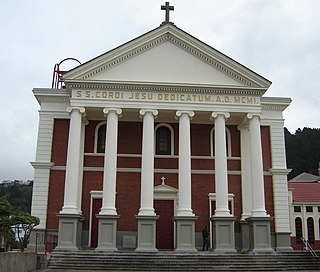
The Metropolitan Cathedral of the Sacred Heart and of Saint Mary His Mother, better known as Sacred Heart Cathedral, is a Roman Catholic cathedral church on Hill Street, Wellington, New Zealand. It is the parish church of the Thorndon Catholic parish and the seat of the Archbishop of Wellington. The New Zealand Parliament is a close neighbour of the cathedral. However, the Thorndon Catholic parish predates that institution. The cathedral is part of a Catholic precinct which includes: St Mary's College; Sacred Heart Cathedral School; St Mary's Convent, the motherhouse of the Sisters of Mercy in Wellington; the Catholic Centre, in which Catholic administration is located; and Viard House, which is both the cathedral parish presbytery and the residence of the archbishop.

St. Dominic's Cathedral, locally known as the Fanchuanpu Tianzhutang, is located by the Min River, Fuzhou, Fujian, China. It is the seat of the Metropolitan Archdiocese of Fuzhou and the Ecclesiastical Province of Fuzhou.

The Metropolitan co-cathedral of Saint Mary Major of Mérida is a Roman Catholic cathedral church in Mérida, Extremadura, western Spain. Since 1994, together with the Metropolitan Cathedral of Saint John the Baptist of Badajoz, it is the seat of the Archdiocese of Mérida-Badajoz.

The Cathedral of the Immaculate Conception of the Holy Virgin Mary is a neo-Gothic Catholic church at Moscow's center, that serves as the cathedral of the Archdiocese of Moscow. Located in the Central Administrative Okrug, it is one of three Catholic churches in Moscow and the largest in Russia.

Basilicas are Catholic church buildings that have a designation, conferring special privileges, given by the Pope. Basilicas are distinguished for ceremonial purposes from other churches. The building need not be a basilica in the architectural sense. Basilicas are either major basilicas, of which there are four, all in the Diocese of Rome, or minor basilicas, of which there were 1,810 worldwide as of 2019.

From June 23 to June 26, 1941, the Ninth National Eucharistic Congress took place in Falcon Heights, Minnesota, at the Minnesota State Fairgrounds. The event, meant to foster devotion to the sacrament of the Eucharist, attracted hundreds of thousands of attendees. While primarily at the Eucharistic Center set up at the fairgrounds, other events took place at Saint Paul Union Depot, the Minneapolis Auditorium, the St. Paul Auditorium, the Cathedral of St. Paul and the Basilica of St. Mary elsewhere in Minnesota.
